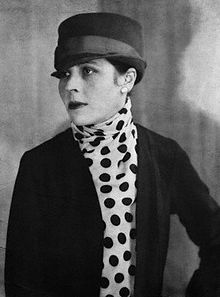Djuna Barnes | |
|---|---|
 Djuna Barnes, c. 1921 | |
| Born | June 12, 1892 Storm King Mountain, Orange County, New York, U.S. |
| Died | June 18, 1982 (aged 90) New York City, U.S. |
| Pen name |
|
| Occupation |
|
| Literary movement | Modernism |
| Notable works | Ladies Almanack (1928) Nightwood (1936) |
Djuna Barnes (/ˈdʒuːnɑː/ JOO-nah; June 12, 1892 – June 18, 1982) was an American artist, illustrator, journalist, and writer who is perhaps best known for her novel Nightwood (1936), a cult classic of lesbian fiction and an important work of modernist literature.[2]
In 1913, Barnes began her career as a freelance journalist and illustrator for the Brooklyn Daily Eagle.[3] By early 1914, Barnes was a highly sought feature reporter, interviewer, and illustrator whose work appeared in the city's leading newspapers and periodicals.[4] Later, Barnes's talent and connections with prominent Greenwich Village bohemians afforded her the opportunity to publish her prose, poems, illustrations, and one-act plays in both avant-garde literary journals and popular magazines, and publish an illustrated volume of poetry, The Book of Repulsive Women (1915).[4][5]
In 1921, a lucrative commission with McCall's took Barnes to Paris, where she lived for the next 10 years.[4] In this period she published A Book (1923), a collection of poetry, plays, and short stories, which was later reissued, with the addition of three stories, as A Night Among the Horses (1929), Ladies Almanack (1928), and Ryder (1928).[6]
During the 1930s, Barnes spent time in England, Paris, New York, and North Africa.[7] It was during this restless time that she wrote and published Nightwood. In October 1939, after nearly two decades living mostly in Europe, Barnes returned to New York.[8] She published her last major work, the verse play The Antiphon, in 1958, and she died in her apartment at Patchin Place, Greenwich Village in June 1982.[9][10]